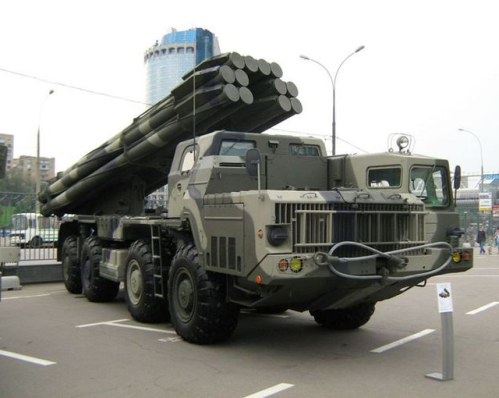
According to Kommersant, Perm-based ZAO Special Design Bureau (SKB) received a contract worth 6-7 billion rubles ($93-$108 million) to produce 20 combat systems for the Russian MOD. The paper’s sources say the contract is for Tornado-S multiple launch rocket systems (MLRS) and transport-reload vehicles. The equipment is to be delivered in 2020.
The 12-tube, 300-mm Tornado-S (9K515) MLRS is a “deeply modernized” version of the Smerch. It reportedly features GLONASS satellite navigation, automated fire control, and 9M542 PGMs. Unlike earlier systems, Tornado-S gives specific flight profile data to each rocket. Its effective range is 120 km.
Tornado-S first entered the inventory in late 2016. Smerch was accepted for service in 1989.
The new 9K515 weapons system includes the 9A54 launch vehicle and 9T255 transport-reload vehicle.

The 20 systems in the contract likely include 16 launch vehicles (two battalions of eight) and four transport-reload vehicles (two per launch battalion).
The Russian MOD is using new Tornado-S MLRS to build a heavy rocket launcher brigade at the district level in each of its four MDs. In Soviet times, each MD (front) disposed of its own rocket launcher brigade, typically four battalions of 18 40-tube, 122-mm BM-21 Grad systems.
Those “brigades” look like this now:
- Western MD…Tver…79th Brigade…three battalions of Tornado-S…12 launchers.
- Southern MD…Znamensk…439th Brigade…??? battalions of Tornado-S…??? launchers.
- Central MD…Shchuchye…232nd Brigade…two battalions of 220-mm Uragan…16 launchers.
- Eastern MD…Novosysoyevka…338th Brigade…2-3 battalions of Uragan…16-18 launchers.
But these are more like rocket battalions than the brigades of old days.
The first Tornado-S deployments began in 2017 in the Western MD and continued in the Southern MD in early 2019.
It seems likely the Tornado-S systems due in 2020 will go to the Central or Eastern MD before the Western or Southern get more.
Kommersant detailed the poor financial status of ZAO SKB. Its parent, long-time sole producer of Russian MLRS Motovilikhinskiye Plants is bankrupt. SKB was split away to keep creditors at bay. The rest of Motovilikha is supposed to retool to make civilian products. The growing problem of insolvency in Russia’s OPK is worthy of a look.





